
Equipment
Truck Tech: February 2014
Before I delve into this first column of a new year, I want to thank every one of you for your support over the past year.
February 10, 2014
By Chris Dennis
Before I delve into this first column of a new year, I want to thank every one of you for your support over the past year. The information sent to me, the questions I have received and the thanks many of you have expressed have all been greatly appreciated.
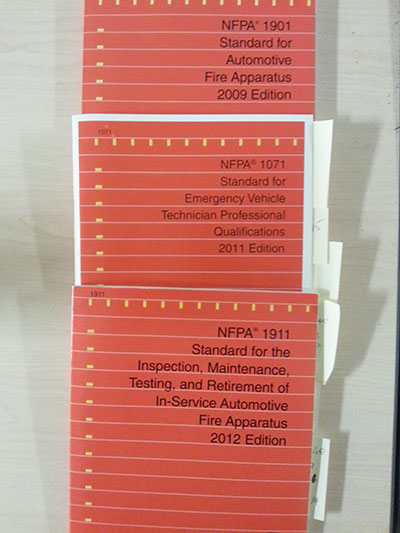 |
|
| When preparing for an audit, look to NFPA standards for guidance. An audit can be useful in gathering information to make your department or division more efficient, though frequent testing should ensure there are no surprises. |
So, what to put on paper for the first issue of 2014? I could talk about preventive maintenance or safety features, or about repairing a fire pump, but I’ll save those topics for later in the year. I am going to talk about something that hit a little to close to home last year: an audit. Wikipedia describes an audit as “systematic and independent examination of data, statements, records, operations and performances (financial or otherwise) of an enterprise for a stated purpose.”
Fire Underwriters Survey conducted the audit for the Vaughan Fire & Rescue Services in Ontario in November 2013. Essentially, the audit was an information-gathering survey that would help our citizens get a better insurance rating from their insurance companies once the survey was documented and shared with those providers. I was not privy to all the information regarding other divisions within our department, but I received an e-mail from the fire chief with the date of the audit and an outline of what would be expected. I thought that if my mechanical division were to get a low score, bringing down the insurance rating for the taxpayers of Vaughan, not only would the fire chief be disappointed, but I would have some explaining to do to more than 280,000 people.
Full-time, composite or volunteer fire departments, with or without mechanical or apparatus divisions, should be prepared for an audit. Not only does an audit help save the taxpayers money but it also makes your fire department more efficient.
These items were addressed and examined:
- Pump test records for the last three to five years
- Aerial and platform test records for the last three to five years
- Mechanical officer development, recruitment, recruit training, ongoing training and professional development, as well qualifications of mechanics
- Record-management system
- Data-management system, specifically related to repairs and testing
- Mechanical division policies and procedures
- Out-of-service policies and procedures
- Apparatus-replacement schedule
- Repair shop staffing and work-order procedures
- Daily truck-check sheets
- Ground-ladder test records and work sheets
- Hose-testing records and work sheets
- Pump-testing facility and work sheets
- Parts inventory
In addition, auditors toured our repair facility and examined the tools and equipment we use to repair and test the trucks. These tools must be up to date with safety standards and compatible with our apparatuses.
■ Pump-test records
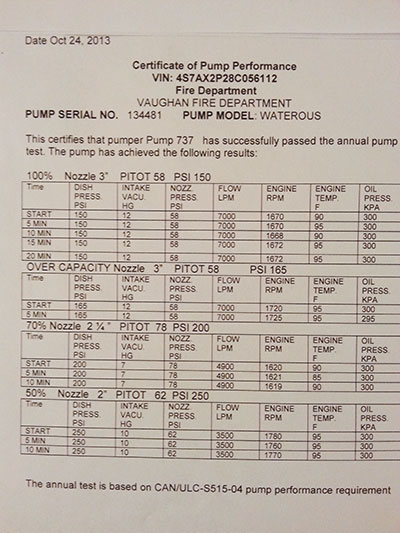 |
|
| These are the results of a pump test performed at Vaughan Fire & Rescue Services. Auditors will want to see these test sheets to ensure that regular pump tests are being done.
|
Underwriters Laboratories of Canada (ULC) should test your fire pump each year. Operational pump testing should be done during every truck check. A certified pump operator will be able to notice when a gauge is not reading correctly just through training or fire-ground operations. The first line of defence in the mechanical division, besides preventive maintenance, is the firefighter. Know your apparatus and the equipment you use, and you will know when something does not feel right.
Use the ULC plate specifications when doing a pump test as these are the numbers the underwriters look for. Not all fire pumps built into apparatuses come with ULC plates. So, if your truck is not equipped with ULC plates, be sure you know what the pump is capable of doing. The builder can provide all of this information. If your department bought a used truck, get the information off the fire pump itself or call the pump manufacturer and get the information guide.
■ Aerial and platform test records
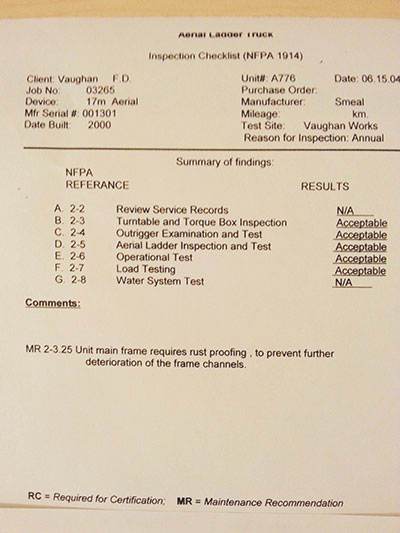 |
|
| This sample from a third-party test sheet offers an example of what to look for during annual aerial ladder checks. While qualified personnel from the department can complete some of these tests, having a third party perform the inspection ensures objectivity. |
A third party should complete aerial and platform tests. According to NFPA 1914, non-destructive tests, which are those that do not cause any damage to the item being tested, must be completed every five years. The standard also calls for annual tests, which are designed for fire department personnel to perform. Depending on the number of aerial- or platform-equipped apparatuses you have in your fleet, you may want to stagger the non-destructive testing across a three- to five-year timeline. This is cost-effective and good practice. The average non-destructive ladder test costs between $800 and $1,600, depending on the style of apparatus and the size of the platform. It takes between four and six hours per truck to perform this test, and the time frame can vary based on the style of apparatus, as well as the company you have hired to do the job.
■ Development, recruitment and ongoing training
The auditors will examine the hiring criteria and the job description for a fire-truck repair technician, as well as the kind of mechanical training offered to staff once hired. The audit will also look at what resources are available to technicians, as well the certifications, licencing and qualifications that the technicians already have or are moving toward. It is important that you have a long-range plan in place for mechanical-technician training, whether it be through the Emergency Vehicle Technician Certification Commission
(www.evtcc.org), a program run through your local fire college, or a program you put together in-house or out of town. All of these things cost money and should be considered when putting together the year’s budget. If you use a local fleet-repair garage in your township or municipality, I recommend that its mechanics have some training specific to fire apparatuses so that they are better equipped to fix any problems. You wouldn’t take your new Ford car to the Toyota dealer for repairs unless Ford happened to have a factory-trained Ford technician on site.
■ Record management
Be sure all work performed on the truck – from simple light bulb changes to complex pump overhauls – is written on a shop work order on which the technician can make notes and sign off when he or she has completed the repair. All of this information can be transferred onto electronic copy; however, the original shop copy is what is most important. All this information can be kept in a file for the duration of the truck’s service. If you sell the truck to another fire department, it is recommended that you transfer the records to that department so its members know what kind of maintenance has been done to it.
■ Review of data management system
The auditors will want to see how the records are kept electronically as well as the outlines for performing the tests and recording their results. Take the annual safety inspection as an example: Where is the list of items to be checked kept? What items are on the list? Who put the list together and what format was used? You must also have written instructions for testing the pumps, nozzles and fire hoses.
■ Apparatus-replacement schedule
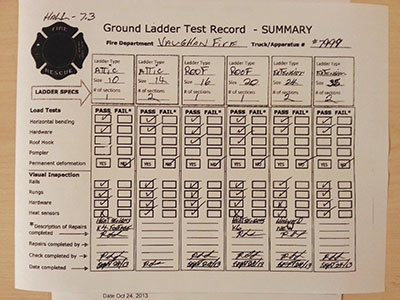 |
|
| Ground ladder test records should include notes about what repairs, if any, were required. These repairs should be completed prior to the ground ladder non-destructive test, which must be done every five years.
|
NFPA 1911 details the criteria for retirement and replacement of a fire truck, while NFPA 1912 outlines refurbishment guidelines. These two standards should be worked together. As an aside, if you can have money designated through a capital project to refurbish a fire truck, then you can make the truck last a bit longer and save the municipality money in two ways. First, if a refurbishment is completed at the 10-year mark instead of at 12 or 15 years, the truck will not be as badly abused. So when a truck becomes 15 or 20 years old, you might have already prevented a catastrophic failure through early refurbishment. Second, when it comes time to sell this truck, you will be able to ask more for it, earning the department more money toward the purchase of a new truck.
■ Staffing and work-order procedures
It is recommended that each department employ one truck technician for every five fire trucks in its fleet. The work-order process is critical and plays a major role not only in repair history but also as a tool that can be used to help protect technicians if there is an accident involving the apparatus. The repair history file for that truck or piece of equipment will be seized if an investigation is ordered.
■ Daily truck checks
In our case in Vaughan, the mechanical division works with the training division to create a daily truck-check sheet. Whether electronic or hand-written, these records must be accurate, with the information going to the correct people and departments so that the job gets done. In order for the truck-check records to be properly filed or the truck documented for repair, the technician must have some means of communicating with the firefighter who is driving the truck or using the equipment. We use both a paper logbook developed by our training division and the deficiencies program outlined by Firehouse Software for truck and equipment repairs.
■ Mechanical division policies and procedures
Your department’s policies and procedures should continuously be works in progress. The NFPA standards as well as other fire departments in your area may be able to help you to develop this program.
■ Hose test and Ground-ladder non-destructive test (NDT) records
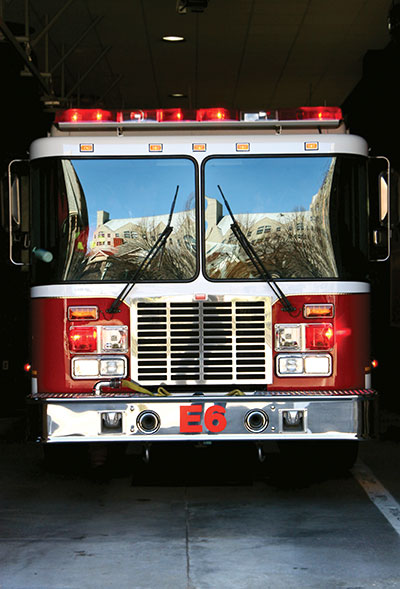 |
|
| Regular maintenance of the truck and its equipment will also help to pass the ground ladder non-destructive test, which must be completed once a year.
|
Fire hoses should be tested and the date of the test should be clearly marked. Both electronic and paper copies documenting these tests should be kept at hand. A serial number should be etched, carved or stamped into the coupling to keep track of the information pertaining to that hose as well. A portable hose tester will pay for itself in the first couple of years by protecting your firefighters from injury and your department from workers’ compensation claims. The fire truck can be used to test the hose; however, it is not as accurate as the portable hose tester, it overheats the fire pump, and the truck must be out of service while the testing is being done.
NFPA 1911 suggests that preventive maintenance, including washing the truck and performing operation checks and inspections, be done after each fire or at least once a week, and should be completed to ensure the operational readiness of the truck. In addition to helping the apparatus pass a ground ladder NDT, which according to NFPA 1932 should be completed once a year and preferably by a third party, preventive maintenance ensures that the truck’s shortcomings are fully known and can be addressed before the NDT so that there are no surprises if a failure is detected.
The last item in the audit is a tour of the repair facility and an up-close look at the tools the mechanical division uses to conduct the repairs. If the auditor asks to see your pitot gauge for testing water discharge flow rate, you had better be able to produce it and, show the area where you do this test.
The entire audit took 3.5 hours and, overall, we did well. Vaughan’s mechanical apparatus division, or, as we call it, Monster Garage, is a work in progress. We are not perfect but we learn from the best. Fire-truck repair technicians get together once a year at the Ontario Fire College in Gravenhurst to discuss what’s old, what’s new and how to fix problems. The technicians you have repairing your fire department apparatuses and equipment are second to none. Provide them the training they need to be sure that your fleet is ready and safe at a moment’s notice.
Remember, rubber side down, my friends!
Chris Dennis is the chief mechanical officer for Vaughan Fire & Rescue Services in Ontario. He can be reached at Chris.Dennis@vaughan.ca
Print this page